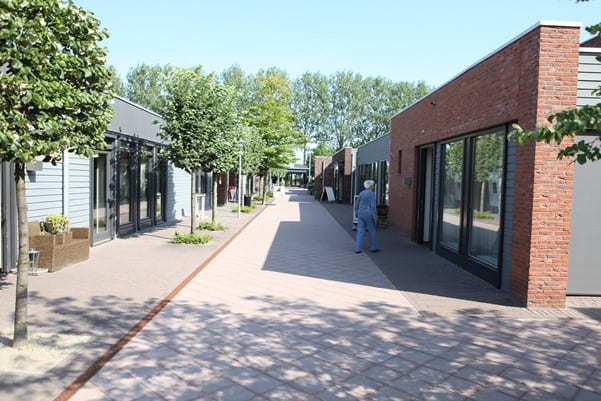Avi Srivastava, Applied Sciences, 22F

Image credit: Hans Erkelens/Flickr, CC BY-NC-SA 2.0
A case of dementia is diagnosed in the world every 3.2 seconds. With the number of patients expected to almost triple to 140 million by 2050 as we live longer—coupled with contemporary anti-dementia medicines and disease-modifying therapies still showing little promise—the search for new safe spaces for people with neurodegenerative disorders is more urgent today than ever (National Health Service UK, 2021; World Health Organization, 2021). Unfortunately, traditional dementia care housing is far from ideal; the physical and chemical restraints (straps, wheelchair bars, antipsychotics, benzodiazepines, etc.) used in public care homes dissuade many from even considering them (World Health Organization, 2021). The Netherlands thinks that it has found a solution in Hogeweyk, a village designed specifically to house people with severe dementia with the help of Universal Design—the composition of an environment so it can be understood and used by all people in it.
In many ways, Hogeweyk is like any other village—it has restaurants, yards, shops, even activity clubs (Furey, 2020). Trying to find the perfect function of intimacy, professionalization, and medicalization, it gives all occupants the license to continue living life as human beings. Residents are allowed to move to increasingly social spaces of their own accord from their rooms, which are designed to mimic their former surroundings. Design interventions that have been shown to improve general navigation like minimal tiles, see-through cabinet doors, and bright tableware are common implements, along with cashless registers and professionally trained assistants that live in (Woodbridge et. al, 2016).
Despite its intuitive advantages though, there is no research to demonstrate that dementia villages in and of themselves improve behavior, functional ability, or cognition, and the model clearly does not work for all patients—many residents are not able to independently benefit from the occupational possibilities, for example, because they require support beyond what can be provided (Pedro et. al, 2020; Peoples et. al, 2019). The search for new space and the funds required to build new villages are also fundamental barriers to the village model’s adoption.
Today, proponents of the village model point to the renovation of malls. Built to provide safety, convenience, and social interactions, their design is perfect for modern dementia housing (Moon et. al, 2018). Additionally, in spite of the aforementioned drawbacks, the academic consensus is that educated design interventions still have a positive impact on general dementia outlook (Marquardt et. al, 2014). Besides preventing self-harm and the possibility of getting lost, adapting domestic environments helps ensure accessibility, independence, and social connectivity for all patients. The only question left to answer regarding outcome is if it’s feasible in a future expecting dramatically more dementia cases.
Recent studies also question the bioethics of architectural intervention as a method of treating medical patients. Friesen (2020) highlights similarities between how dementia patients and children are treated—their wants and needs are often considered inexpressible and so generally go unconsidered. The dementia village model hinges on goodwill deception resting on the notion that validation therapy (communication where the therapist accepts the disorientation of the patient) is our best solution. This furthers the idea that people suffering from cognitive decline cannot be involved in decision-making or even remotely articulate their needs, desires, and goals. Others point out that the facility’s architecture also raises new questions about the intentionality of clinical judgment and disclosure (Anderson et. al, 2022).
With new villages opening in both the US and the UK, the dementia village model looks like it’s here to stay—at least until we’re brave enough to tackle feasibility and ethical concerns through further experimentation (Richmond Villages, n.d.; MemoryCare, n.d.).
References
Anderson, D. C., Teti, S. L., Hercules, W. J., Deemer, D. A. (2022). The Bioethics of Built Space: Health Care Architecture as a Medical Intervention. The Hastings Center Report, 52(2), 32-40. https://doi.org/10.1002/hast.1353
Furrey, M. (2020, February 6). The ‘Dementia Village’ of the Netherlands. University Times. https://universitytimes.ie/2020/02/the-dementia-village-of-the-netherlands
Friesen, P. & Dionne, É. (2022). “It’s All in Your Head”: Magic and Misdirection in Medicine. Science & Technology Studies, 35(2), 72-96. https://doi.org/10.23987/sts.110291
Marquardt, G., Bueter, K., & Motzek, T. (2014). Impact of the Design of the Built Environment on People with Dementia: An Evidence-based Review. Health Environments Research & Design Journal, 8(1), 127–157. https://doi.org/10.1177/193758671400800111
MemoryCare (n.d.). The Best Memory Care Facilities in Indianapolis, IN. https://www.memorycare.com/indianapolis-in-facilities
Moon, O. K., Yeum, D. M., & Choi, W. S. (2018). A Study on the Living Environment of the Residents of the Dementia Care Village. Journal of International Academy of Physical Therapy Research, 9(4), 1636-1641. http://jiaptr.org/journal/article.php?code=65071
National Health Service. (2021, April 8). Is there a cure for dementia? https://www.nhs.uk/conditions/dementia/cure
Pedro, C., Duarte, M., Jorge, B., & Freitas, D. (2020). 440 – Dementia Villages: Rethinking Dementia Care. International Psychogeriatrics, 32(S1), 158. https://doi.org/10.1017/S1041610220002926
Peoples, H., Pedersen, L. F., & Moestrup, L. (2019, August 30). Integrating an occupational perspective on health in dementia enabling communities. Paper presented at Occupational Science Europe Conference, Amsterdam, Netherlands. https://www.ucviden.dk/en/publications/integrating-an-occupational-perspective-on-health-in-dementia-ena
Richmond Villages. (n.d.). Dementia Care Village Willaston. https://www.richmond-villages.com/retirement-villages/willaston
Woodbridge, R., Sullivan, M. P., Harding, E., Crutch, S., Gilhooly, K. J., Gilhooly, M. L. M., Mclyntre, A., & Wilson, L. (2016). Use of the Physical Environment to Support Everyday Activities for People with Dementia: A Systematic Review. Dementia 17(5), 533-572. https://doi.org/10.1177/1471301216648670
World Health Organization. (2021, September 2). Dementia. https://www.who.int/news-room/fact-sheets/detail/dementia
Leave a Reply